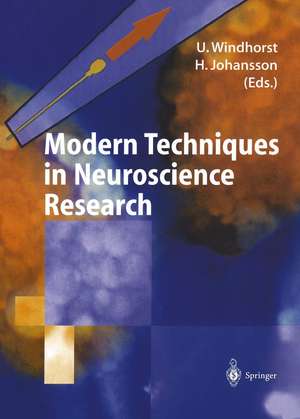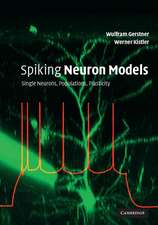Modern Techniques in Neuroscience Research
Editat de Uwe Windhorst, Hakan Johanssonen Limba Engleză Paperback – 5 oct 2013
Preț: 539.86 lei
Nou
Puncte Express: 810
Preț estimativ în valută:
103.32€ • 107.64$ • 85.90£
103.32€ • 107.64$ • 85.90£
Carte tipărită la comandă
Livrare economică 04-10 februarie 25
Preluare comenzi: 021 569.72.76
Specificații
ISBN-13: 9783642636431
ISBN-10: 3642636438
Pagini: 1384
Ilustrații: L, 1328 p. 478 illus., 15 illus. in color. In 2 volumes, not available separately.
Dimensiuni: 193 x 270 x 73 mm
Ediția:Softcover reprint of the original 1st ed. 1999
Editura: Springer Berlin, Heidelberg
Colecția Springer
Locul publicării:Berlin, Heidelberg, Germany
ISBN-10: 3642636438
Pagini: 1384
Ilustrații: L, 1328 p. 478 illus., 15 illus. in color. In 2 volumes, not available separately.
Dimensiuni: 193 x 270 x 73 mm
Ediția:Softcover reprint of the original 1st ed. 1999
Editura: Springer Berlin, Heidelberg
Colecția Springer
Locul publicării:Berlin, Heidelberg, Germany
Public țintă
Professional/practitionerCuprins
1 Cytological Staining Methods.- 2 Application of Differential Display and Serial Analysis of Gene Expression in the Nervous System.- 3 Methods Towards Detection of Protein Synthesis in Dendrites and Axons.- 4 Optical Recording from Individual Neurons in Culture.- 5 Electrical Activity of Individual Neurons In Situ: Extra-and Intracellular Recording.- 6 Electrical Activity of Individual Neurons: Patch-Clamp Techniques.- 7 Microiontophoresis and Pressure Ejection.- 8 An Introduction to the Principles of Neuronal Modelling.- 9 In Vitro Preparations.- 10 Culturing CNS Neurons: A Practical Approach to Cultured Embryonic Chick Neurons.- 11 Neural Stem Cell Isolation, Characterization and Transplantation.- Chapter12 In Vitro Reconstruction of Neuronal Circuits: A Simple Model System Approach.- 13 Grafting of Peripheral Nerves and Schwann Cells into the CNS to Support Axon Regeneration.- 14 Cell and Tissue Transplantation in the Rodent CNS.- 15 Histological Staining Methods.- 16 Optical Recording from Populations of Neurons in Brain Slices.- 17 Recording of Electrical Activity of Neuronal Populations.- 18 Time and Frequency Domain Analysis of Spike Train and Time Series Data.- 19 Information-Theoretical Analysis of Sensory Information.- 20 Information-Theoretical Analysis of Small Neuronal Networks.- 21 Linear Systems Description.- 22 Nonlinear Analysis of Neuronal Systems.- 23 Dynamical Stability Analyses of Coordination Patterns.- 24 Detection of Chaos and Fractals from Experimental Time Series.- 25 Neural Networks and Modeling of Neuronal Networks.- 26 Acquisition, Processing and Analysis of the Surface Electromyogram.- 27 Decomposition and Analysis of Intramuscular Electromyographic Signals.- 28 Relating Muscle Activity to Movement in Animals.- 29 Long-term Cuff ElectrodeRecordings from Peripheral Nerves in Animals and Humans.- 30 Microneurography in Humans.- 31 Biomechanical Analysis of Human and Animal Movement.- 32 Detection and Classification of Synergies in Multijoint Movement with Applications to Gait Analysis.- 33 Magnetic Stimulation of the Nervous System.- 34 In-vivo Optical Imaging of Cortical Architecture and Dynamics.- 35 Electroencephalography.- 36 Modern Techniques in ERP Research.- 37 Magnetoencephalography.- 38 Magnetic Resonance Imaging of Human Brain Function.- 39 Positron Emission Tomography of the Human Brain.- 40 Magnetic Resonance Spectroscopy of the Human Brain.- 41 Monitoring Chemistry of Brain Microenvironment: Biosensors, Microdialysis and Related Techniques.- 42 Invasive Techniques in Humans: Microelectrode Recordings and Microstimulation.- 43 Psychophysical Methods.- 44 Analysis of Behavior in Laboratory Rodents.- 45 Data Acquisition, Processing and Storage.
Textul de pe ultima copertă
Neuroscience has become a rapidly expanding young science that relies on a number of other sciences and their methods. For that reason it is a truly interdisciplinary and inter-methodological undertaking of much fascination to many. In this spirit, this book attempts at presenting an overview of the techniques currently used in modern neuroscience research. By doing so, it is also an introduction into neuroscience itself, from the angle of methods available to tackle prevailing questions. Many questions can only be answered by combining methods borrowed from different fields. Building on this insight, this book's organizing principle is the investigation of levels of the nervous system, from molecular and cellular to whole organisms. The reasons are twofold. First, certain organizational levels can be optimally studied and potentially understood only by applying an array of diverse techniques. Second, it is important to avoid succumbing to the danger of pure technicality, which might arise from ordering the description of techniques according to their inherent principles of coherence (e.g. staining vs. electrophysiological techniques). In addition, this book aims at providing a direct working tool for the user in the laboratory and clinic and thus addresses all active neuroscience researchers, from graduate students to supervisors. The main emphasis in terms of layout is on detailed step-by-step protocols including personal tips and recommendations. Most chapters or protocols are organized so that they can be used independently. Moreover, cross-references to other techniques in other chapters, which are aimed at studying the same object(s) from a different angle, help create the pertinent context.
Caracteristici
A complete collection of all techniques useful to neuroscience research Provides a research-oriented combination of techniques and strategies for optimizing research work Aids problem-solving in the design of experiments A unique and userfriendly structure by research level makes information easy to find















